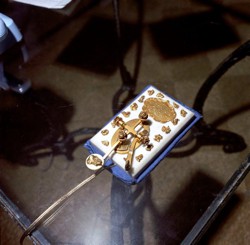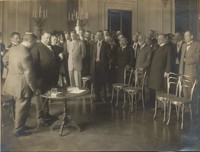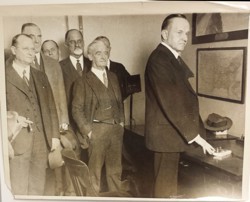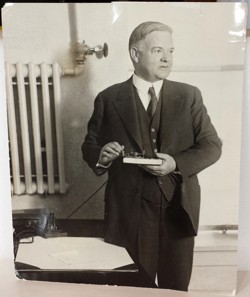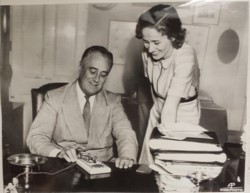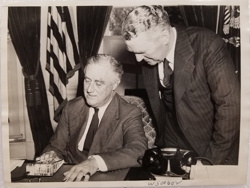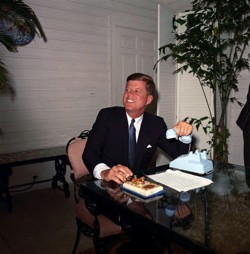Special Telegraph Instruments
The following are some examples of very special telegraph instruments, which were involved with important historical events or used by famous people.
The Vail Key & Register
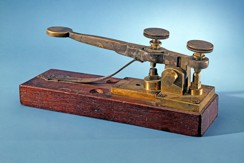 |
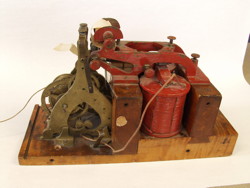 |
|---|
On May 24, 1844, Samuel FB Morse demonstrated his telegraph in Washington DC in front of President Millard Fillmore and others. The telegraph instruments used in this demonstration were designed by Alfred Vail. Vail actually participated in the demonstration. Morse was in Washington DC in the Supreme Court Chambers in the basement of the US Capitol, while Vail was in Baltimore at the B&O Railroad Mount Clare Station. It was during this demonstration that Morse sent the famous words "What Hath God Wrought" ?
Following the demonstration, Vail kept the register he used in his home in Baltimore. Before he died in 1859, he willed the register to his son Stephen. Eventually Stephen Vail sold the register to Cornell University, where it is still on display today.
One of the original Vail keys is on display at the Smithsonian Museum.
The location of the 2nd key and register is unknown.
The Perry Set (Japan)
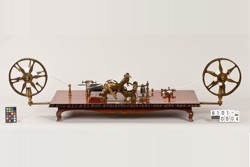 |
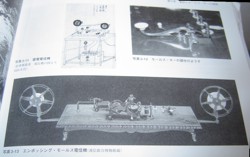 |
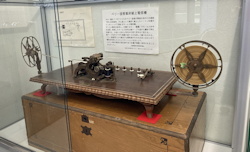 |
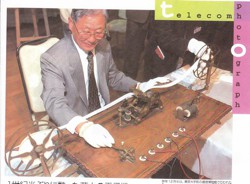 |
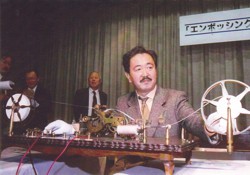 |
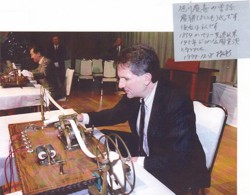 |
| Pictures of the 1999 demostration with the original and replica Perry Sets | ||
For over 200 years prior to the 1850's, Japan was a closed country. No foreigner was permitted to enter the country and no Japanese could leave under penalty of death. There were a few exceptions such as the city of Nagasaki, which was open to limited foreign trade with the Dutch, Chinese, and Koreans, but by and large Japan was completely isolated from the outside world.
In 1852, US President Millard Fillmore assigned Commodore Matthew Perry to force the opening of Japanese ports to trade with the US. Perry reached Edo Bay in Japan (now known as Tokyo) in July of 1853 on the paddle wheel steamship Mississippi. The Japanese of course demanded he leave but he threatened them with force and eventually the Japanese relented and allowed Perry to land at which time they accepted a letter with demands to open Japanese ports. Perry said he would return in a year to receive their reply.
Instead of a year, Perry returned just 6 months later in February 1854 to begin negotiations with Japan. At this time, Perry presented the Japanese government with a gift of a telegraph set to show them what was essentially the latest in modern technology. This set was made by JW Norton and Charles T Chester, New York, and has come to be known as The Perry Set.
The Perry Set is currently on display in the NTT Museum in Tokyo.
Well, actually the set that is on display is an identical replica of the Perry Set. The original set is locked away safely in a vault in the museum.
The pictures in the top row show the Perry Set from the museum. In the bottom row are pictures from a 1999 demonstration where the original Perry Set and the replica are being used. The operator on the left is Yoshitomo Tokugawa, a direct decendant of Yoshinobu Tokugawa, the last Shogun from the Tokugawa Shogunate, which ended in 1867.
The Vanderslice Key
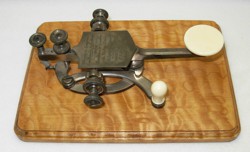 |
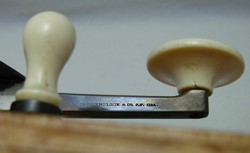 |
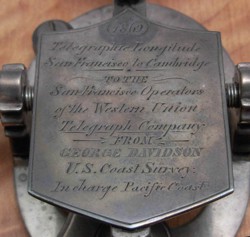 |
|---|
In the Mid-1850's the US Government set about trying to accurately map the Pacific coast. Measuring latitude was easy as it was just a matter of measuring the position relative to the North Star. But measuring longitude was more difficult. It required that one knows the time difference between a known position and the position of interest.
This is where the telegraph was invaluable. Stations were set up in Boston and San Francisco. Chronometers at each end were attached to the telegraph line which would transmit timing signals to allow the station on the west coast to synchronize with the local time in Boston. The time difference between the east and west coast stations was then converted to degrees.
Leading the effort in this survey was Geographer George Davidson. Following the completion of the survey in 1869, Davidson presented a special solid-silver telegraph key to the Western Union telegraphers involved in the survey. This key was made by the San Francisco silversmith William Vanderslice. Vanderslice was best known for silver plating and engraving the hammers used to drive in the final ceremonial spikes in the meeting of the Central Pacific and Union Pacific rail lines at Promontory Point, Utah in 1869, which finally connected the east and west railroads, making transcontinental rail travel possible.
The Schaefer Set
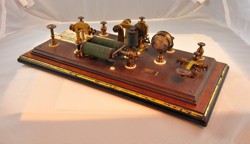 |
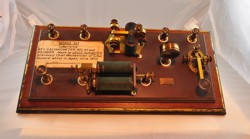 |
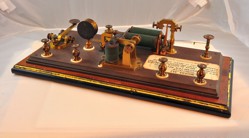 |
|---|
Louis Schaefer was a highly skilled Mechanician from Germany. In his native country, he spent some time working for Siemens & Haske Telegraph Co. then emigrated to Louisville, Kentucky in 1854.
While in Kentucky, he met British-American inventor Professor David Hughes who had come up with an idea for a printing telegraph. Schaefer, being the master machinist that he was, built the first working model that would be called the Hughes Printing Telegraph. To see a picture of the Hughes Printing Telegraph Prototype (which is in the Smithsonian Museum), click here.
Schaefer later went to work for the Eastern Telegraph Company, stationed in Malta. He became the Chief Mechanician on the Great Eastern, the ship that laid the first Trans-Atlantic undersea telegraph cable in 1858.
Around 1871, Schaefer and his wife moved to Japan where he would work on undersea cable systems to connect Japan with China and Korea. Schaefer built this beautiful Morse set around 1872 while he was in Japan. The set consists of a miniature key, sounder, relay, and galvanometer with ivory insulators. The set has a small nameplate inscribed "L. Schaefer, Tokio". (Yes, they spelled it with an "I" back then.)
Solid Gold Presentation Key
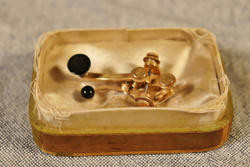 |
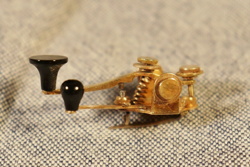 |
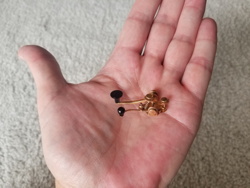 |
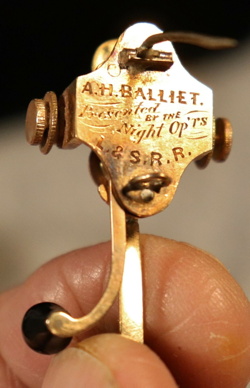 |
A.H. Balliet was born on July 9th, 1852 in Easton, Pennsyslvania. After graduating from the Easton Collegiate Institute, he started to learn telegraphy. After becoming proficient, he took a job with the Lehigh & Susquehanna Railroad Company as a telegrapher. After a short time he was appointed to the position of Train Dispatcher, which he held for several years. When he decided to leave the company sometime in the late 1870s, his telegrapher co-workers gathered at The Mansion House in Mauch Chunk, PA, and presented him with a solid 14k gold miniature telegraph key, engraved on the underside .
The Taft Key
In 1909 President William Howard Taft was given a special telegraph key to be used to signal the opening of the 1909 Yukon-Alaska-Pacific Exposition in Seattle.
The key was presented by George Carmack, the man who first discovered gold in the Yukon Territories. The key was made of solid gold and was adorned with 22 solid gold nuggets that were found by Mr. Carmack. The key was mounted on a piece of Alaskan marble. This key, which is known as The Taft Key, thus became the official telegraph key used by 7 different US Presidents to signal the opening of various events around the country.
Following the 1909 ceremony, Taft gave the key to the White House Chief Telegrapher Edward Smithers who continued to use the key until his death in 1939, when the key was given to Smithers' widow. Since the Taft Key was no longer at the White House, a new chrome plated Presidential Key was made and presented to Franklin Delano Roosevelt in April 1939, when he used it to signal the opening of the Omaha Railroad Celebration.
The Taft Key was used for the last time by a President in 1962 when the key was loaned to President Kennedy to signal the opening of the Seattle World's Fair in 1962.
In 1999, Smithers Grandson, Thomas D. Quinn Jr, donated the key back to the White House. The Taft Key is currently on loan to the Smithsonian where it is on display for the public to enjoy.

